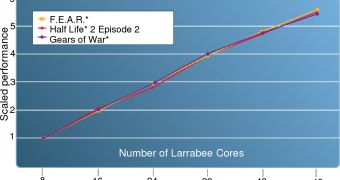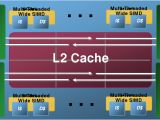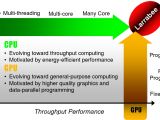Intel decided it's high time to give us a few more details on its upcoming Larrabee 'visual computing' architecture. The company talked a little more about the discrete graphics product it plans to launch somewhere in the 2009-2010 time frame. Some pieces of information on the new technology had already been made public by the chips manufacturer, but no specifications on the way it actually works or on how much it can offer have been published until now.
Intel's presentation to analysts and journalists unveiled the fact that Larrabee would feature from 8 to 48 cores, depending on the model, just the way CPUs do. The idea behind the new architecture, the company says, it to push the graphics beyond gaming. Larrabee will not be compared to the current graphics processors on the market, as it relies on CPU programmability and GPU multi-parallelism, featuring many smaller cores, compared to the single or dual core architecture ATI and Nvidia offer on their current cards.
The many-core x86 design of Intel's graphics solution promises "full support of current graphics APIs", as well as a starting point for the development of APIs with new features. According to the company, the x86 coding will provide advantages and unique characteristics that cannot be found in a GPU. A 1024 bits-wide bi-directional ring network (512 bits in each direction) has been developed for Larrabee, enabling the communication between agents in low latency manner, and Intel says that this will be a "super fast communication between cores".
We have already showed how each Larrabee core is a full x86 one and that the product is based on a modernized dual-issue Pentium design featuring a short execution pipeline. The design received enhancements through a vector processing unit (VPU; 16 32-bit ops per clock), multi-threading (4x with separate register sets per thread), 64-bit extensions and sophisticated pre-fetching.
The company has described Larrabee as highly scalable from the beginning, which means that the 48-core architecture is a plausible one. Previous rumors pointed to such numbers, and some went even to the 128-core mark. Still, the eight-core chip is the one we should probably expect for the 2009-2010 period. The number of threads the product can deal with simultaneously rises up from 32 to 192 when it comes to Hyperthreading.
Intel said that the performance level Larrabee could reach is a secret, when a question on how many cores are required to match the power of an Nvidia or an ATI GPU popped up. We should expect the chips manufacturer to come to the market with a product capable of more than is available at the time of launch.
According to Intel, the one feature that matters the most in Larrabee would be scalability, since the company said that linear scaling is available for games like Gears of War, FEAR or Half-Life 2, Episode 2. The performance brought by eight cores will be doubled at 16 and tripled at 24, while 32 cores would bring four times that speed. As Intel says, that is "almost linearly", or "linearly within 10%," if rephrased.
Among other interesting features of Larrabee, the company announced the full support for the "IEEE standards for single and double precision floating-point arithmetic". The support for double-precision processing is featured by AMD's and Nvidia's GPGPUs as well, but they suffer performance losses when facing double-precision apps. The Tesla cards were presented by Nvidia as capable of 900 GFlops to 1 TFlops in single-precisions, but the performance drops to 100 GFlops in double-precisions. Intel said nothing about double-precision environments affecting Larrabee.

 14 DAY TRIAL //
14 DAY TRIAL // 

